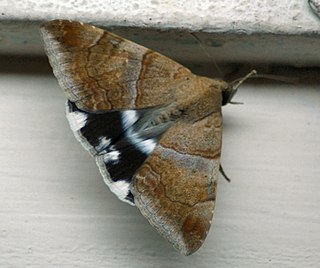
Achaea janata, the castor semi-looper or croton caterpillar, is an erebid moth, the caterpillars of which are termed 'semi-loopers' due to their mode of locomotion. It is found from the Indo-Australian tropics and subtropics, extending south to New Zealand and east through the Pacific archipelagoes to Easter Island. It is a major pest of castor throughout the world.

Mythimna decisissima is a moth of the family Noctuidae first described by Francis Walker in 1856. It is found from India across south-east Asia including Hong Kong, Japan, Taiwan and Australia in Queensland and New South Wales. It is also present in South Africa.

Pterocyclophora pictimargo is a moth of the family Noctuidae. It was first described by George Hampson in 1893 and it is found in Sri Lanka.
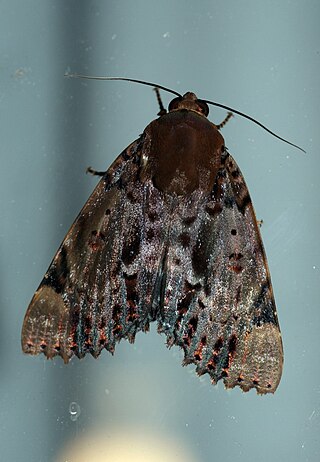
Arcte coerula, the ramie moth, is a moth of the family Noctuidae. The species was first described by Achille Guenée in 1852. It is found from in south-east Asia, including Fiji, India, Sri Lanka, Myanmar, Japan, New Guinea, Taiwan and Norfolk Island. It has been recently observed in Hawaii, on the island of Maui.

Thyas coronata is a species of moth of the family Erebidae first described by Johan Christian Fabricius in 1775. It is found from the Indo-Australian tropics of southern China, Taiwan, Japan, Nepal, India, Sri Lanka to Micronesia and the Society Islands.
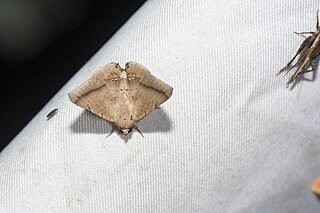
Macaldenia palumba is a moth of the family Noctuidae first described by Achille Guenée in 1852. It is found from the Oriental region of India, Sri Lanka to Japan (Okinawa) and Sundaland, east to New Guinea. It is also found on Guam in Micronesia.

Eudocima phalonia, the common fruit-piercing moth, is a fruit piercing moth of the family Erebidae. The species was first described by Carl Linnaeus in his 1763 Centuria Insectorum. It is found in large parts of the tropics, mainly in Asia, Africa and Australia but introduced into other areas such as Hawaii, New Zealand and the Society Islands. It is one of major fruit pests in the world.

Ctenoplusia limbirena, the Scar Bank gem, or silver U-tail, is a moth of the family Noctuidae. It is found in south-western Europe, Africa, the Canary Islands, Arabia, the southern Himalayas, India, Sri Lanka, Indochina to south-eastern China, Taiwan, Sulawesi, Bali and Timor. In New Zealand, it has been established since 2011.

Chiasmia emersaria is a moth of the family Geometridae. The species was first described by Francis Walker in 1861. It is found in India, Nepal, northern Thailand, China, Sri Lanka, Japan and the Ryukyu Islands.
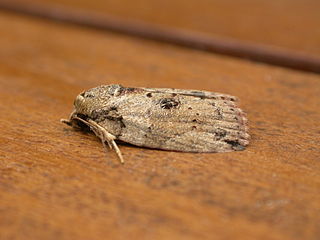
Nanaguna breviuscula, the pigeonpea pod borer, is a moth species of the family Nolidae. It is found from Sri Lanka and India east to Samoa. In Australia it is found in the Kimberleys in Western Australia, the northern part of the Northern Territory and from the Torres Strait Islands and Queensland to Sydney in New South Wales.

Tiracola plagiata, the cacao armyworm, is a species of moth in the family Noctuidae. The species was first described by Francis Walker in 1857. It is found from south-east Asia, southern India, Sri Lanka, Myanmar to the South Pacific Islands, including the northern two-thirds of Australia.

Ischyja manlia is a species of moth of the family Noctuidae first described by Pieter Cramer in 1776. It is found in the Indian subregion, Sri Lanka, Myanmar, Thailand, China, Okinawa, Sundaland, Sulawesi, Korea, the southern Moluccas, Australia (Queensland) and Palau.
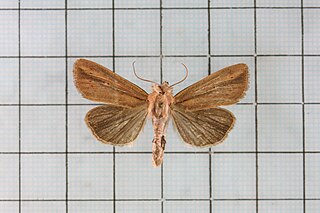
Mythimna pallidicosta is a moth in the family Noctuidae first described by George Hampson in 1894. It is found from north-eastern India to western China, Sri Lanka, Taiwan, Sundaland, Flores, the Philippines and Japan.
Ertzica morosella is a species of snout moth in the genus Ertzica. It was described by Francis Walker in 1863 and is known from Indonesia, India, Sri Lanka and the Philippines.

Gesonia obeditalis is a species of moth of the family Noctuidae first described by Francis Walker in 1859. It is found from eastern Africa, the Seychelles, the Maldives and the Oriental tropics of India, Myanmar, Sri Lanka east to the Philippines, the Sula Islands and Australia. The adult moth has brown wings with a scalloped dark brown band near the margin. The hindwings are similar in pattern to the forewings but are a paler shade of brown.

Plusiodonta coelonota, the snake vine moth, is a species of moth in the family Erebidae. The species was first described by Vincenz Kollar in 1844. It is found from India, Sri Lanka, Myanmar, Andaman Islands, Australia, Papua New Guinea, to South and South-East Asia.

Autoba abrupta is a species of moth of the family Erebidae. It is found in Papua New Guinea, Thailand, and Australia. The species is largely used by the name Eublemma abrupta in Indian and Sri Lankan texts.
Risoba obstructa is a species of moth of the family Nolidae first described by Frederic Moore in 1881.

Risoba repugnans is a species of moth of the family Nolidae first described by Francis Walker in 1865.
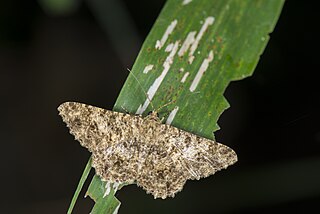
Racotis boarmiaria is a species of moth of the family Geometridae described by Achille Guenée in 1857. It is found in India, Sri Lanka, Maldives, Myanmar, China, Japan, Taiwan, Indonesia, Bhutan and Malaysia.

















